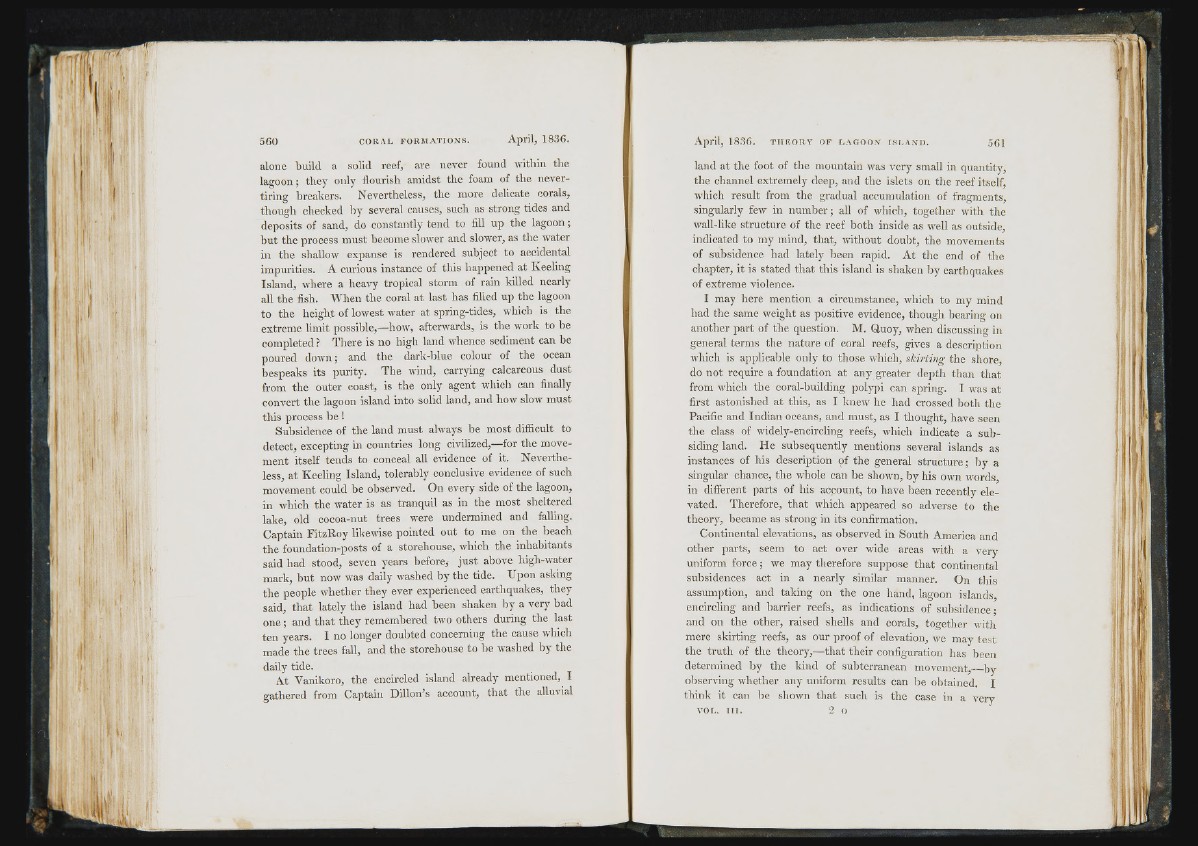
V i
li
560 COKA L FORMATIONS. April, 1836.
alone build a solid reef, are never found within the
lagoon; they only flourish amidst the foam of the never-
tiring breakers. Nevertheless, the more delicate corals,
though checked hy several causes, such as strong tides and
deposits of sand, do constantly tend to fill up the lagoon;
but the process must become slower and slower, as the water
in the shallow expanse is rendered subject to accidental
impurities. A curious instance of this happened at Keeling
Island, where a heavy tropical storm of rain killed nearly
all the fish. When the coral at last has filled up the lagoon
to the height of lowest water at spring-tides, which is the
extreme limit possible,—how, afterwards, is the work to be
completed ? There is no high land whence sediment ean be
poured down; and the dark-blue colour of the ocean
bespeaks its purity. The wind, carrying calcareous dust
from the outer coast, is the only agent which can finally
convert the lagoon island into solid land, and how slow must
this process he !
Subsidence of the land must always be most difficult to
detect, excepting in countries long civilized,—for the movement
itself tends to conceal all evidence of it. Nevertheless,
at Keeling Island, tolerably conclusive evidence of such
movement could be observed. On every side of the lagoon,
in which the water is as tranquil as in the most sheltered
lake, old cocoa-nut trees were undermined and falling.
Captain FitzRoy likewise pointed out to me on the beach
the foundation-posts of a storehouse, which the mhabitants
said had stood, seven years before, just above high-water
mark, but now was daily washed by the tide. Upon asking
the people whether they ever experienced earthquakes, they
said, that lately the island had been shaken by a very bad
one ; and that they remembered two others during the last
ten years. I no longer doubted concerning the cause which
made the trees fall, and the storehouse to be washed by the
daily tide.
At Vanikoro, the encircled island already mentioned, I
gathered from Captain Dillon’s account, that the alluvial
.April, 1836. T H E O R Y o f l a g o o n i s l a n d . 561
land at the foot of the mountain was very small in quantity,
the channel extremely deep, and the islets on the reef itself,
which result from the gradual accumulation of fragments,
singularly few in number; all of which, together with the
wall-like structure of the reef both inside as well as outside,
indicated to my mind, that, without doubt, the movements
of subsidence had lately been rapid. At the end of the
chapter, it is stated that this island is shaken by earthquakes
of extreme violence.
I may here mention a circumstance, which to my mind
had the same weight as positive evidence, though bearing on
another part of the question. M. Quoy, when discussing in
general terms the nature of coral reefs, gives a description
which is applicable only to those which, skirting the shore,
do not require a foundation at any greater depth than that
from which the coral-building polypi can spring. I was at
first astonished at this, as I knew he had crossed both the
Pacific and Indian oceans, and must, as I thought, have seen
the class of widely-encircling reefs, which indicate a subsiding
land. He subsequently mentions several islands as
instances of his description of the general structure; by a
singular chance, the whole can be shown, by his own words,
in different parts of his account, to have been recently elevated.
Therefore, that which appeared so adverse to the
theory, became as strong in its confirmation.
Continental elevations, as observed in South America and
other parts, seem to act over wide areas with a very
uniform force; we may therefore suppose that continental
subsidences act in a nearly similar manner. On tliis
assumption, and taking on the one hand, lagoon island.s,
encircling and barrier reefs, as indications of subsidence;
and on the other, raised shells and corals, together with
mere skirting reefs, as our proof of elevation, we may test
the truth of the theory,—that their configuration has been
determined by the kind of subterranean movement, by
observing whether any uniform results can be obtained. I
think it can be shown that such is the case in
VOL, I I I . 2 o
very